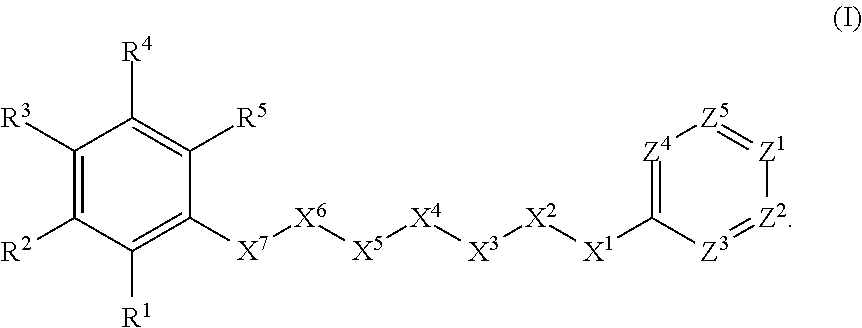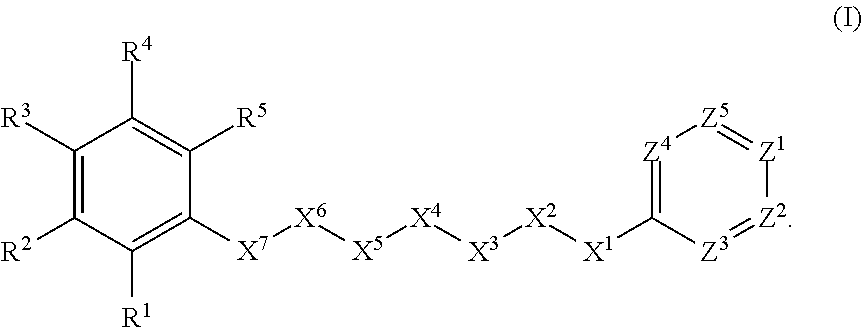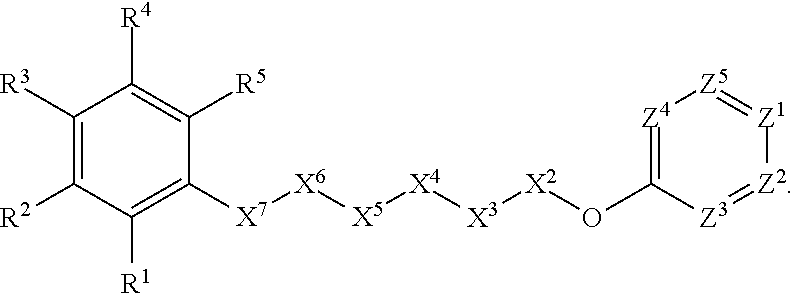Anthelmintic agents and their use
a technology of anthelmintic agents and their use, applied in the field of compounds, can solve the problems of obsolete drugs, known drugs may have other deficiencies, and substantial suffering and economic losses in the world
- Summary
- Abstract
- Description
- Claims
- Application Information
AI Technical Summary
Benefits of technology
Problems solved by technology
Method used
Image
Examples
example 1
Protocols for Analyzing Compounds Prepared in Accordance with this Invention
[0227]Applicants prepared a plethora of compounds of this invention. The identities and purities were characterized and verified using various analytical high performance liquid chromatography (“HPLC”) and mass spectroscopy (“MS”) protocols. These protocols are discussed below.
System I
[0228]In some instances, the compound analysis was conducted using an HPLC / MSD 1100 (Agilent, Santa Clara, Calif., USA) having a binary pump (G1312A) with a degasser (G1379A), a well plate sampler (G1367A), a column oven (G1316A), a diode array detector (G1315B), a mass detector (G1946D SL) with an ESI-source, and an evaporating light detector (Sedex 75). Four different columns and detection methods were used with this system:
Protocol I-A
[0229]The column used for this protocol was a Zorbax SB-C18 (Agilent), having a 4.6 mm diameter, a 30 mm length, and 3.5 μm packing. The column was operated at 30° C. (ambient temperature). The...
example 2
Preparation of 1-(4-trifluormethyl-phenyl)-2,5-dimethylpiperazine intermediate (also known as trans-2,5-dimethyl-1-(4-trifluoromethyl-phenyl)-piperazine)
[0237]
4-Bromobenzotrifluoride (1.35 g, 6.0 mmol), trans-2,5-dimethylpiperazine (582 mg, 5.1 mmol), tris-(dibenzylideneacetone)-dipalladium (240 mg, 0.26 mmol), 2-(dicyclohexylphosphino)-biphenyl (252 mg, 0.72 mmol) were dissolved in toluene (6 mL). A molar solution of lithium bis(trimethylsilyl)-amide (12 mL, 12 mmol) was then added. The resulting mixture was heated to 85° C. and stirred at that temperature for 6.5 hr. The mixture was then cooled to room temperature and diluted with diethyl ether (20 mL). The precipitate was separated by filtration, and the filtrate was concentrated under vacuum. Purification by column chromatography on silica gel (dichloromethane / methanol 1:0, 8:2) afforded the desired product as a brown oil (760 mg, 58% yield).
[0238]In many instances, the method of Example 2 can be adapted to make other compounds ...
example 3
Preparation of 1-chloracetyl-4-(4-trifluormethyl-phenyl)-2,5-dimethylpiperazine intermediate (also known as 2-chloro-1-[trans-2,5-dimethyl-4-(4-trifluoromethyl-phenyl)-piperazin-1-yl]ethanone)
[0239]
1-(4-Trifluormethyl-phenyl)-2,5-dimethylpiperazine (760 mg, 2.94 mmol, prepared in accordance with Example 2) and triethylamine (820 μL, 5.88 mmol) were dissolved in dichloromethane (5 mL). Chloroacetyl chloride (234 μL, 2.94 mmol) was then slowly added under stirring. After stirring for an additional 20 min at room temperature, the mixture was diluted with dichloromethane (10 mL), washed with water (10 mL), and washed with saturated aqueous sodium hydrogencarbonate (10 mL). The organic layer was collected, dried over magnesium sulfate, filtered, and concentrated under vacuum. The desired product was isolated as a light yellow oil (340 mg, 35% yield).
PUM
| Property | Measurement | Unit |
|---|---|---|
| flow rate | aaaaa | aaaaa |
| volume | aaaaa | aaaaa |
| length | aaaaa | aaaaa |
Abstract
Description
Claims
Application Information
 Login to View More
Login to View More - R&D
- Intellectual Property
- Life Sciences
- Materials
- Tech Scout
- Unparalleled Data Quality
- Higher Quality Content
- 60% Fewer Hallucinations
Browse by: Latest US Patents, China's latest patents, Technical Efficacy Thesaurus, Application Domain, Technology Topic, Popular Technical Reports.
© 2025 PatSnap. All rights reserved.Legal|Privacy policy|Modern Slavery Act Transparency Statement|Sitemap|About US| Contact US: help@patsnap.com



